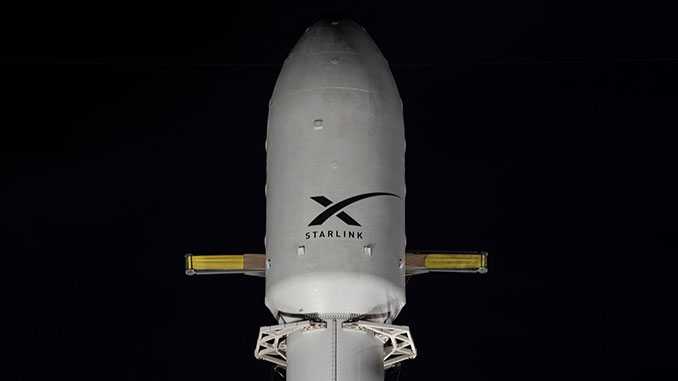
File: A Falcon 9 rocket stands ready to launch a Starlink mission. Image: SpaceX
SpaceX launched its latest batch of 21 Starlink satellites on a Thursday night Falcon 9 launch from California.
The Falcon 9 rocket launch set a new record for Vandenberg Space Force Base, marking the first time that 31 orbital missions have taken off in a calendar year. Thirty of those launches were from SpaceX and one was from Firefly Aerospace.
Liftoff of the Starlink 9-6 mission from Space Launch Complex 4 East (SLC-4E) happened at 6:45 p.m. PDT (9:45 p.m. EDT, 0145 UTC).
The Falcon 9 first stage booster supporting this mission, tail number B1071 in the SpaceX fleet, launched for an 18th time. It previously flew three missions for the National Reconnaissance Office (NROL-87, NROL-85 and NROL-146), two rideshare missions (Transporter-8 and Transporter-9) and ten Starlink missions.
A little more than eight minutes after liftoff, B1071 landed on the SpaceX droneship ‘Of Course I Still Love You.’ This was the 101st landing on OCISLY and the 348th booster landing to date.
Among the 21 Starlink satellites are 13 that include Direct to Cell capabilities. With this launch, SpaceX will have a total of 207 of these satellites capable of providing signals to regular cellphones. According to expert orbital tracker and astronomer Jonathan McDowell, there are currently more than 6,400 Starlink satellites on orbit.

A diagram of the Starlink direct-to-cell service. Graphic: SpaceX
Dragon demo
Some hours after the launch from California, four astronauts orbiting in low Earth orbit will conduct a unique demonstration of the technology. The Starlink demonstration comes on flight day four for the Polaris Dawn mission.
A Starlink WiFi router is located within the Crew Dragon Resilience spacecraft, which is connected to to a laser system embedded within the trunk of the Dragon called the “Plug and Plaser.”
“You might think getting internet might be as easy as flipping that switch and turning on your internet, but it’s not. We’re talking about a laser sending information to a Starlink satellite that is moving at orbital velocity, down to Earth and then back again,” said Sarah Gillis, a Polaris Dawn mission specialist and SpaceX engineer. “It’s been an incredible development effort by the SpaceX team and on a personal note, I’ve taken specific interest in this development effort and we have a special message that we will share with the world, using this technology.”
Hello Earth –
We are so grateful for all the support! Please enjoy two recent photos from our mission and stay tuned for our next message
Sent to you from space over a beam of Starlink laser light
– Crew of Polaris Dawn pic.twitter.com/KkeZw1yAoT
— Polaris (@PolarisProgram) September 12, 2024
In a precursor to the formal demonstration, the Polaris Program shared a post on X, formerly Twitter, in which it said that the two embedded images of the crew and the Earth were sent via Starlink.
Part of the goal Polaris Program is supporting St. Jude Children Research Hospital and to do so, they are also bringing Starlink internet service to some of their locations around the world. They brought Starlink terminals to schools and hospitals in developing countries to bolster their connectivity.